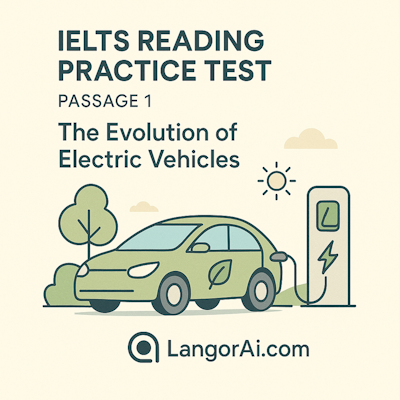
IELTS Reading Practice Test – Passage 1
The Evolution of Electric Vehicles
Electric vehicles (EVs) have experienced a dramatic transformation over the past two decades. Initially dismissed as impractical due to limited range and long charging times, they are now positioned as central to the global effort to reduce carbon emissions. The evolution of EVs has been driven by technological innovation, policy incentives, and shifting consumer attitudes.
In the early 2000s, the idea of replacing internal combustion engines with battery-powered motors was considered overly optimistic. Battery technology at that time was expensive and inefficient, offering fewer than 100 kilometers per charge. However, advancements in lithium-ion battery design around 2010 revolutionized the industry, allowing for higher energy density, faster charging, and lower costs. This breakthrough coincided with increasing concerns about climate change, encouraging governments to promote cleaner transport alternatives.
Major automakers, once skeptical, began investing heavily in EV technology. Tesla’s Model S, launched in 2012, demonstrated that electric cars could be both desirable and high-performing. The company’s focus on design, range, and charging infrastructure helped reshape public perception. Other manufacturers followed suit, introducing hybrid and fully electric models to compete in the rapidly growing market.
Governments worldwide introduced subsidies, tax reductions, and free parking incentives for electric car owners. Countries such as Norway and the Netherlands became early leaders, achieving significant EV market penetration by 2020. At the same time, countries like China turned EV production into a strategic national priority, investing billions in manufacturing and battery research.
Despite these developments, challenges remain. The production of lithium-ion batteries raises environmental concerns, especially regarding mining and disposal. Moreover, in regions where electricity still relies heavily on fossil fuels, the overall reduction in carbon emissions is less significant. Nevertheless, ongoing research into solid-state batteries, renewable-powered charging stations, and battery recycling may help address these issues in the coming decade.
As of the mid-2020s, electric vehicles are no longer a futuristic concept—they are a practical reality. While widespread adoption depends on infrastructure and affordability, the trajectory is clear: the future of mobility is electric.
Questions 1–15
Choose the correct letter, A, B, C, or D.
A) Government restrictions
B) Lack of public interest
C) Limited battery capacity and efficiency
D) Competition from diesel vehicles
A) Cheaper manufacturing materials
B) Development of lithium-ion batteries
C) Stricter environmental laws
D) Introduction of electric motorcycles
A) It was affordable for everyone.
B) It showed EVs could be stylish and powerful.
C) It introduced hybrid technology.
D) It focused mainly on cost reduction.
A) Germany
B) Japan
C) China
D) Canada
A) Overuse of solar energy
B) Deforestation
C) Problems with mining and disposal
D) Air pollution from traffic
A) Roads are unsuitable for EVs
B) Fossil fuels are still used for electricity
C) Charging stations are too expensive
D) Batteries are too small
A) They will be replaced by hydrogen cars.
B) Their popularity is likely to decline.
C) They are becoming a mainstream transportation option.
D) Governments will stop supporting them soon.
A) Skeptical
B) Optimistic
C) Neutral
D) Negative
A) Decline in oil prices
B) Concerns about climate change
C) Desire to reduce traffic congestion
D) Pressure from car manufacturers
A) Ford
B) Toyota
C) Tesla
D) Nissan
A) Fuel efficiency
B) Range, safety, and recycling
C) Car design only
D) Government regulations
A) Norway and the Netherlands
B) USA and Japan
C) France and Germany
D) Australia and the UK
A) Lack of awareness
B) Media criticism
C) Poor battery performance
D) Limited charging stations
A) EVs are futuristic but impractical.
B) EVs are now a realistic part of modern transport.
C) EVs have failed to reduce pollution.
D) EVs are no longer necessary.
A) The outcome is uncertain
B) The direction of progress is obvious
C) The technology is slowing down
D) The government controls the market
Answer Key & Explanations
1 → C – Early EVs had limited range and efficiency due to poor batteries.
2 → B – Lithium-ion battery innovation changed everything.
3 → B – Tesla proved EVs could be desirable and high-performing.
4 → C – China invested heavily in EV production.
5 → C – Mining and disposal cause environmental harm.
6 → B – Using fossil fuels for electricity reduces EV benefits.
7 → C – EVs are now mainstream and practical.
8 → B – Tone is optimistic.
9 → B – Governments acted due to climate concerns.
10 → C – Tesla led public attitude change.
11 → B – Solid-state batteries aim to improve range, safety, and recyclability.
12 → A – Norway and the Netherlands were pioneers.
13 → C – Poor battery performance caused doubt.
14 → B – EVs are now a practical part of modern transport.
15 → B – “Trajectory” = clear direction of progress.
